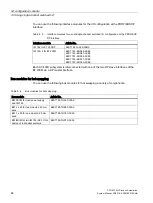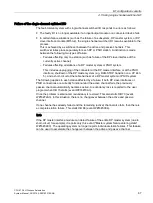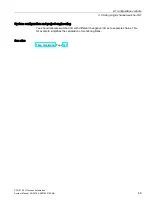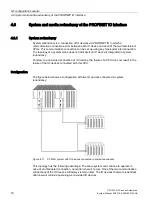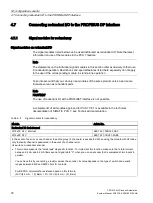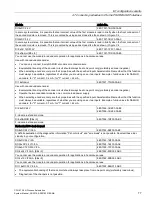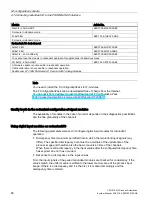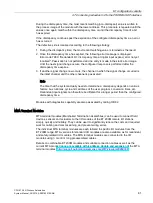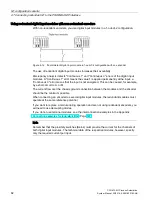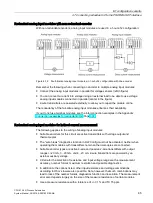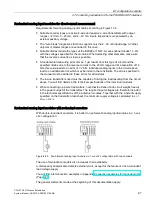
I/O configuration variants
4.7 Connecting redundant I/O to the PROFIBUS DP interface
CPU 410-5H Process Automation
78
System Manual, 09/2014, A5E31622160-AB
Module
Article No.
DO 16xDC 24 V/0.5 A
6ES7322-8BH10-0AB0
•
The equipotential bonding of the load circuit should always take place from one point only (preferably load minus).
DO 10xDC 24 V/2 A
6ES7326–2BF00–0AB0
6ES7326–2BF01–0AB0
F-module in standard mode
Redundant AI dual-channel
AI8x12Bit
6ES7331-7KF02-0AB0
Use in voltage measurement
•
The "wire break" diagnostics function in HW Config must not be activated, neither when operating the modules with
transmitters nor when thermocouples are connected.
Use for indirect current measurement
•
When determining the measuring error, observe the following: The total input resistance in measuring ranges > 2.5 V is
reduced from a nominal 100 kilohm to 50 kilohm when operating two inputs connected in parallel.
•
The "wire break" diagnostics function in HW Config must not be activated, neither when operating the modules with
transmitters nor when thermocouples are connected.
•
Use a 50 ohm resistor (measuring range +/- 1 V) or 250 ohm resistor (measuring range 1 - 5 V) to map the current on a
voltage, see figure 11-4. The tolerance of the resistor must be added on to the module error.
•
This module is not suitable for direct current measurement.
Use of redundant encoders:
•
You can use a redundant encoder with the following voltage settings:
+/- 80 mV (only without wire break monitoring)
+/- 250 mV (only without wire break monitoring)
+/- 500 mV (wire break monitoring not configurable)
+/- 1 V (wire break monitoring not configurable)
+/- 2.5 V (wire break monitoring not configurable)
+/- 5 V (wire break monitoring not configurable)
+/- 10 V (wire break monitoring not configurable)
1...5 V (wire break monitoring not configurable)
AI 8x16Bit
6ES7 331-7NF00-0AB0
Use in voltage measurement
•
The "wire break" diagnostics function in HW Config must not be activated when operating the modules with transmit-
ters.
Use in indirect current measurement
•
When using indirect current measurement, ensure a reliable connection between the sensor resistances and the actual
inputs, because a reliable wire break detection cannot be guaranteed in the case of a wire break of individual cables of
this connection.
•
Use a 250 ohm resistor (measuring range 1 - 5 V) to map the current on a voltage; see figure 11-4.
Use in direct current measurement
•
Suitable Zener diode: BZX85C8v2
•
Circuit-specific additional error: If one module fails, the other may suddenly show an additional error of approx. 0.1%.
•
Load capability of 4-wire transmitters: R
B
> 610 ohms
(determined for worst case: 1 input + 1 Zener diode at an S7 overload value 24 mA to R
B
= (R
E
* I
max
+ U
z max
)/I
max)
•
Input voltage in the circuit when operating with a 2-wire transmitter: U
e-2w
< 15 V
(determined for worst case: 1 input + 1 Zener diode at an S7 overload value 24 mA to U
e-2w
= R
E
* I
max
+ U
z max
)

